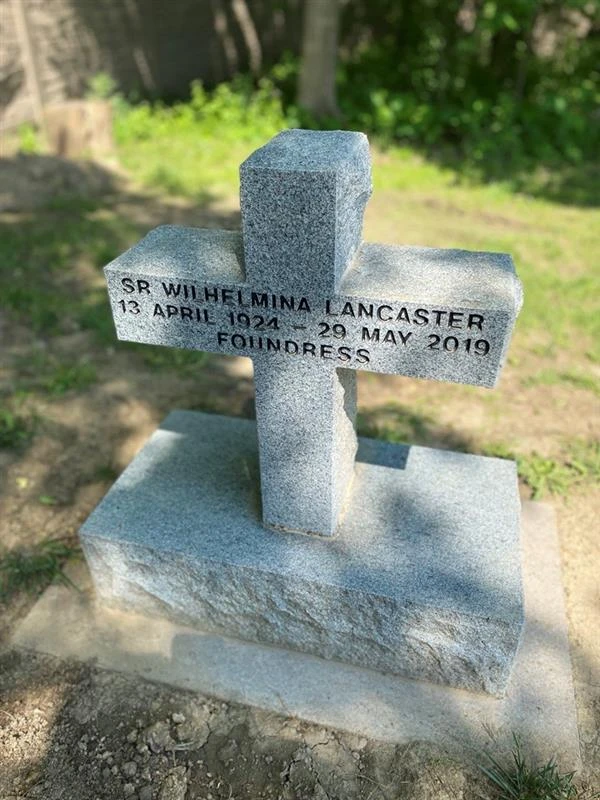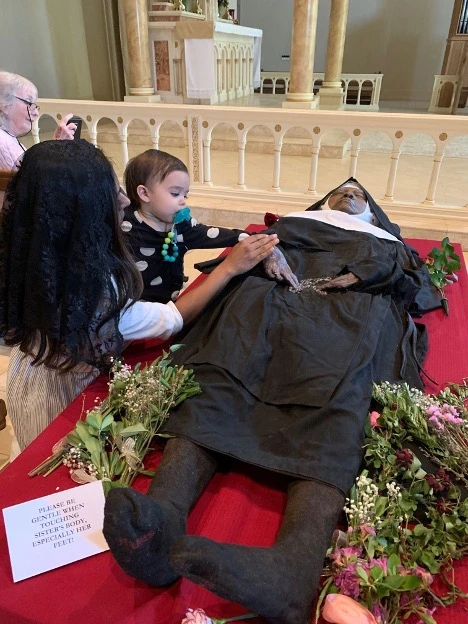Gower, Missouri, May 22, 2023 / 10:15 am
Hundreds of pilgrims have descended on a Benedictine monastery for religious sisters in rural Missouri in recent days after news began to spread on social media last week that the recently exhumed remains of the contemplative order’s African American foundress appear to be incorrupt, four years after her death and burial in a simple wooden coffin.
Sister Wilhelmina Lancaster, OSB, founded the Benedictine Sisters of Mary, Queen of the Apostles — best known for their chart-topping Gregorian chant and classic Catholic hymn albums — in 1995 at the age of 70, leaving the Oblate Sisters of Providence, her community of over 50 years, to do so.
Known for her devotion to the Traditional Latin Mass and her faithfulness to Benedictine contemplation and the Liturgy of the Hours, she died at age 95 on May 29, 2019, on the vigil of the solemnity of the Ascension.
Roughly four years later, on the solemnity of the Ascension in the Latin rite, the abbess and sisters decided to move her body to a final resting place inside their monastery chapel, a long-standing custom for founders and foundresses.
Expecting to find bones, the Benedictine Sisters instead unearthed a coffin with an apparently intact body, even though the body was not embalmed and the wooden coffin had a crack down the middle that let in moisture and dirt for an unknown length of time during those four years.
“We think she is the first African American woman to be found incorrupt,” the current abbess of the community, Mother Cecilia, OSB, told EWTN’s ACI Group on Saturday. As the head of the monastery, it was her role to examine what was in the coffin first.
The body was covered in a layer of mold that had grown due to the high levels of condensation within the cracked coffin. Despite the dampness, little of her body and nothing of her habit disintegrated during the four years.
The shock was instant for the community who had gathered to exhume her.
“I thought I saw a completely full, intact foot and I said, ‘I didn’t just see that,’” the abbess said. “So I looked again more carefully.”
After she looked again, she screamed aloud, “I see her foot!” and the community, she said, “just cheered.”
“I mean there was just this sense that the Lord was doing this,” she said. “Right now we need hope. We need it. Our Lord knows that. And she was such a testament to hope. And faith. And trust.”
The Catholic Church has a long-standing tradition of so-called “incorruptible saints,” more than a hundred of whom have been beatified or canonized. The saints are called incorruptible because years after their death parts of or even the entirety of their bodies are immune to the natural process of decay. Even with modern embalming techniques, bodies are subject to natural processes of decomposition.
According to Catholic tradition, incorruptible saints give witness to the truth of the resurrection of the body and the life that is to come. The lack of decay is also seen as a sign of holiness: a life of grace lived so closely to Christ that sin with its corruption does not proceed in typical fashion but is miraculously held at bay.
‘A beautiful sign’
Rumors of a flood cracking open the grave and the sisters’ examining the coffin by flashlight in the middle of the night are highly exaggerated, the abbess told the ACI Group.
“I had to have the flashlight because you can’t really see in a dark crack even with the sunshine. I thought I saw a foot, but I just paused because, you know, it’s not every day you look into a coffin,” she recounted. “So there’s kind of a sense of a little bit of hesitation — what am I going to see?”
(Story continues below)
Mindful of the crack and the dirt in the coffin, the sisters carefully removed the body. The skeletal remains should have weighed about 20 pounds. Instead, the sisters were lifting what they estimated to be a body weighing “between 80-90 pounds,” the abbess said.

The sisters have since produced a fact sheet to answer questions about the exhumation.
“Not only was her body in a remarkable preserved condition, her crown and bouquet of flowers were dried in place; the profession candle with the ribbon, her crucifix, and rosary were all intact,” the sisters reported.
“Even more remarkable was the complete preservation of her holy habit, made from natural fibers, for which she fought so vigorously throughout her religious life. They synthetic veil was perfectly intact, while the lining of the coffin, made of similar material, was completely deteriorated and gone.”
Abbess Cecilia stressed that the preservation of the habit is a large part of what she sees as miraculous, because the habit is “a beautiful sign that this life is not all there is.”
“People see us and it’s like ‘Oh, she’s a sister, oh she’s wearing that because she’s giving her life, she believes in God. Maybe I should think about God,’” she said, noting that the habit is “a sign of the things to come, of the supernatural and of our last end: heaven, hell, purgatory.”
“This is not possible,” she said of the incorruptible sister’s body. “God is real. He protected that body and that habit to enkindle our faith, to rekindle it, to bring people back to the faith.”
What comes next?
“You can’t Google ‘what do you do with an incorrupt body?’” Abbess Cecilia said, “so we started with the basics, just cleaning her with hot water because clinging to her face was basically a mask of thick mold.”
This process as well as exposure to the air caused the body to lose some but not all of its volume, and as a result a darkening of the skin also took place.
For the time being, the sisters have crafted a wax mask for Sister Wilhelmina’s face. One of her eyes — both were found to still exist, along with eyelashes and eyebrows — was sunken in by the weight of the dirt within the casket. The sisters also coated her hands with wax.
The body will be laid out in the sisters’ chapel until May 29, when the sisters plan a rosary procession. After the procession, Sister Wilhelmina’s body will be encased in glass” near the altar of St. Joseph in the chapel in order to “welcome her growing number of devotees,” according to the sisters’ fact sheet.
Catholic pilgrims already arriving
Since text messages and social media posts began to circulate last week with pictures of the incorrupt body, hundreds of pilgrims have already journeyed to visit the incorrupt sister, sometimes from hours away in Kentucky, Illinois, or closer nearby in Missouri, to pray in front of the body and to get to know better this woman whom many feel had a deep holiness.
“It was beautiful,” said Mary Lou Enna, 86, a pilgrim who came with her son and his wife from nearby Kansas City, a roughly 45-minute drive away. “At first, it was just a little unreal. But then as I just gazed at her, tears started coming and I just knew it was for real and very, very meaningful.”
“I know this happens a lot in Europe through the Church,” she said, “but it was just something I wanted to be at.”
Royce Hood hosts a Catholic radio show in Illinois. He and his wife, Elise, packed their six children in the car from Peoria to come and see what was happening. “I feel like people are like, ‘Wow, we need this right now,’” he said.
“There’s so much chaos and darkness in the world. I think God is giving us little graces to remind us of what is to come and what’s waiting for us.”
“We love our faith,” Elise Hood added. “It just seemed unreal to come and see and be with and touch a sister who is incorruptible. What a blessing to have this opportunity and for our kids to see and witness this, too.”
Ava Hood, 9, said she was amazed. Her brother Augustine agreed.
“They knelt for a long time and just prayed,” said their mother, who added: “It’s still giving me chills. Everything we practice in our daily faith life we can come here and just feel it and see it.”
The sight was no less amazing to Rick Enna, another pilgrim from Kansas City.
“It was miraculous to see her body in perfect condition after her body was in a grave for close to four years,” remarked Enna, 61.
“In a world right now that’s really struggling with so many false gods, we are seeing glimpses of evidence that God is there,” he said. “Those of us who are faithful don’t need evidence, but when we see evidence, then we know it.”
He added: “You don’t see this very often.”

Joe and Tanya Schultz and their children drove eight and a half hours from Louisville, Kentucky, in a caravan with relatives from Springfield, Missouri, to pray before Sister Wilhelmina’s body.
“It’s a great miracle,” said Tanya Schultz, who was touching rosaries and scapulars and the hand of her toddler to the body.
“It’s believable and unbelievable at the same time,” added Joe Schultz upon viewing the body.
“Her being a traditional nun in this time when it is persecuted, we wanted to be present for that and ask for her intercession in the Church since she probably has some great intercessory powers for us, our family, our vocation.”
Through the eyes of her Catholic faith, the abbess sees in the preservation of Sister Wilhelmina’s body that same message. “Heaven is real. The resurrection is real. Especially during these times in the Church and in the world,” she said.
“Have hope,” she implored. “God is still there. He still hears our prayers. He still listens. He still loves us.”
While the Church has not ruled Sister Wilhelmina’s case to be miraculous and the case has not yet been ruled an incorruptible — nor has a cause for the foundress’ canonization been sanctioned — both the sisters of her community and the visitors drawn to the monastery agree that something out of the ordinary course of nature is happening in Gower, Missouri.
“Have faith,” Abbess Cecilia concluded. “Life does not end when we take our last breath: It begins.”
“And this is the kind of miracle that reminds us of that.”





